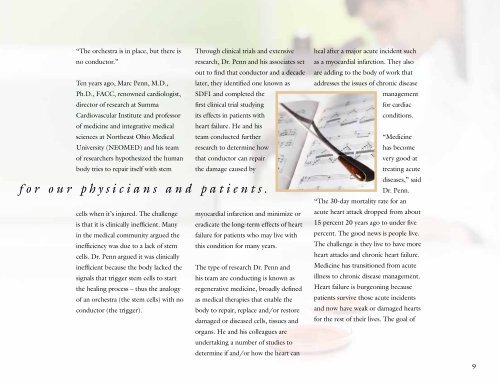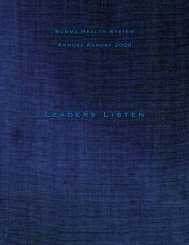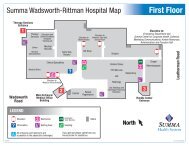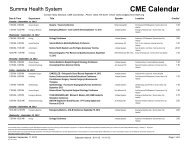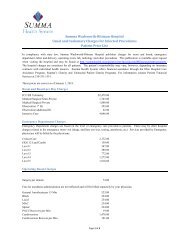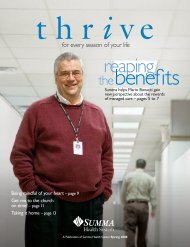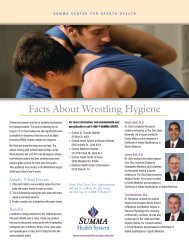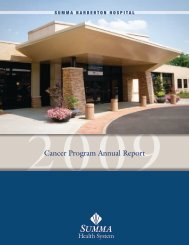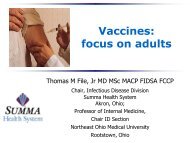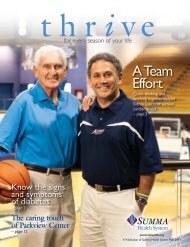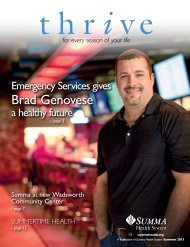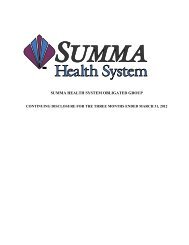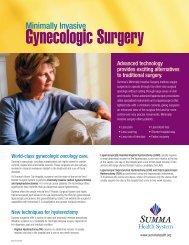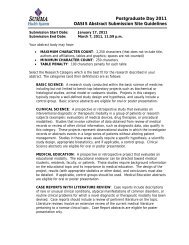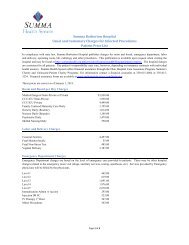2011 Annual Report - Summa Health System
2011 Annual Report - Summa Health System
2011 Annual Report - Summa Health System
You also want an ePaper? Increase the reach of your titles
YUMPU automatically turns print PDFs into web optimized ePapers that Google loves.
“The orchestra is in place, but there is Through clinical trials and extensive<br />
no conductor.”<br />
research, Dr. Penn and his associates set<br />
out to find that conductor and a decade<br />
Ten years ago, Marc Penn, M.D., later, they identified one known as<br />
Ph.D., FACC, renowned cardiologist, SDF1 and completed the<br />
director of research at <strong>Summa</strong><br />
first clinical trial studying<br />
Cardiovascular Institute and professor its effects in patients with<br />
of medicine and integrative medical heart failure. He and his<br />
sciences at Northeast Ohio Medical team conducted further<br />
University (NEOMED) and his team research to determine how<br />
of researchers hypothesized the human that conductor can repair<br />
body tries to repair itself with stem the damage caused by<br />
f o r o u r p h y s i c i a n s a n d p a t i e n t s .<br />
cells when it’s injured. The challenge myocardial infarction and minimize or<br />
is that it is clinically inefficient. Many eradicate the long-term effects of heart<br />
in the medical community argued the failure for patients who may live with<br />
inefficiency was due to a lack of stem this condition for many years.<br />
cells. Dr. Penn argued it was clinically<br />
inefficient because the body lacked the The type of research Dr. Penn and<br />
signals that trigger stem cells to start his team are conducting is known as<br />
the healing process – thus the analogy regenerative medicine, broadly defined<br />
of an orchestra (the stem cells) with no as medical therapies that enable the<br />
conductor (the trigger).<br />
body to repair, replace and/or restore<br />
damaged or diseased cells, tissues and<br />
organs. He and his colleagues are<br />
undertaking a number of studies to<br />
determine if and/or how the heart can<br />
heal after a major acute incident such<br />
as a myocardial infarction. They also<br />
are adding to the body of work that<br />
addresses the issues of chronic disease<br />
management<br />
for cardiac<br />
conditions.<br />
“Medicine<br />
has become<br />
very good at<br />
treating acute<br />
diseases,” said<br />
Dr. Penn.<br />
“The 30-day mortality rate for an<br />
acute heart attack dropped from about<br />
15 percent 20 years ago to under five<br />
percent. The good news is people live.<br />
The challenge is they live to have more<br />
heart attacks and chronic heart failure.<br />
Medicine has transitioned from acute<br />
illness to chronic disease management.<br />
Heart failure is burgeoning because<br />
patients survive those acute incidents<br />
and now have weak or damaged hearts<br />
for the rest of their lives. The goal of<br />
9


